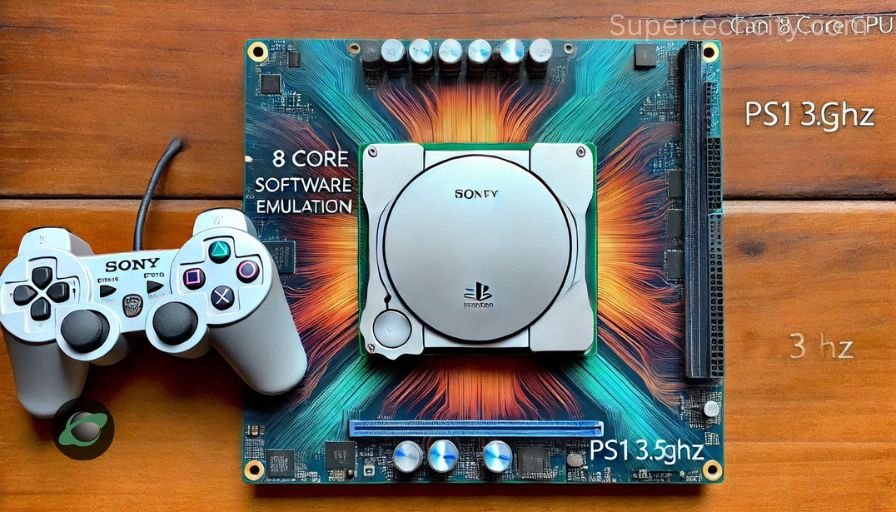Emulating classic gaming consoles like the PlayStation 1 (PS1) has become increasingly popular among retro gaming enthusiasts. One common question is whether an 8-core CPU running at 3.5GHz can handle PS1 software emulation. The simple answer is yes—such a setup is more than capable of providing a seamless emulation experience. Let’s explore the details to understand why.
What Is PS1 Emulation?
PS1 emulation replicates the original console’s hardware and software environment, allowing games to run on a PC or other compatible devices. To achieve this, emulators mimic the PS1’s CPU, GPU, and other components. While this process is complex, modern hardware significantly simplifies the task.
Minimum and Recommended Requirements for PS1 Emulation
Minimum Requirements
- Processor: Single-core CPU with at least 2.0 GHz
- RAM: 2GB
- Graphics Card: Basic GPU with OpenGL 2.0 support
Recommended Requirements
- Processor: Dual-core CPU with at least 3.0 GHz
- RAM: 4GB or higher
- Graphics Card: Mid-range GPU with support for OpenGL 3.1 or Direct3D 11
An 8-core CPU at 3.5GHz far exceeds these requirements, making it an excellent choice for PS1 emulation.
Why an 8-Core CPU at 3.5GHz Is Ideal for PS1 Emulation
High Clock Speed
The 3.5GHz clock speed ensures fast processing, reducing latency during gameplay. This is critical for smooth performance, especially in games with fast-paced action.
Multi-Core Efficiency
While most PS1 emulators primarily utilize one core for emulation tasks, having multiple cores allows the system to handle background processes efficiently. This prevents any slowdowns caused by system overheads.
Support for Advanced Features
Modern CPUs like an 8-core processor can easily handle enhanced emulator features, such as:
- High-Resolution Rendering: Upscaling games for improved visuals.
- Texture Filtering: Smoothing pixelated graphics for a better gaming experience.
- Frame Rate Stability: Ensuring consistent performance, even in demanding games.
Factors That Affect Emulation Performance
While a powerful CPU is crucial, other factors also play a role in achieving optimal performance:
Graphics Processing Unit (GPU)
- Although PS1 emulation is not GPU-intensive, a GPU with OpenGL 3.1 or Direct3D 11 support enhances rendering quality.
Memory (RAM)
- At least 4GB of RAM ensures smooth operation of the emulator and background applications.
Storage
- Using an SSD can reduce loading times for games and improve overall system responsiveness.
Tips for Optimizing PS1 Emulation
To maximize the performance of PS1 emulators on your 8-core 3.5GHz CPU, follow these tips:
- Choose the Right Emulator: Modern emulators like DuckStation offer excellent performance and compatibility with advanced features.
- Configure Settings: Adjust resolution, frame limiting, and texture filtering for the best balance of performance and visuals.
- Keep Software Updated: Regularly update your emulator and system drivers to take advantage of the latest improvements.
- Use a Quality BIOS: A reliable PS1 BIOS file ensures better compatibility and fewer glitches.
- Game Controller Setup: Connect a compatible controller for a more authentic gameplay experience.
FAQs About PS1 Emulation on an 8-Core 3.5GHz CPU
1. Is an 8-core CPU overkill for PS1 emulation?
Yes, it is more than sufficient. While PS1 emulators primarily rely on single-core performance, the additional cores ensure system stability and efficient multitasking.
2. Can PS1 emulators upscale games to modern resolutions?
Yes, most modern emulators support upscaling, allowing you to play games at higher resolutions than the original console.
3. Do I need a high-end GPU for PS1 emulation?
No, a mid-range GPU with OpenGL 3.1 support is sufficient, as PS1 emulation is more CPU-focused.
4. How much RAM is needed for PS1 emulation?
At least 4GB of RAM is recommended for smooth performance, though most modern systems already exceed this.
Conclusion
An 8-core CPU running at 3.5GHz is more than capable of handling PS1 software emulation, delivering smooth gameplay and supporting advanced features like upscaling and texture filtering. Combined with a reliable GPU, sufficient RAM, and an optimized emulator setup, this hardware configuration ensures an enjoyable retro gaming experience. With the right settings, you can relive classic PS1 games in enhanced quality on modern systems.


